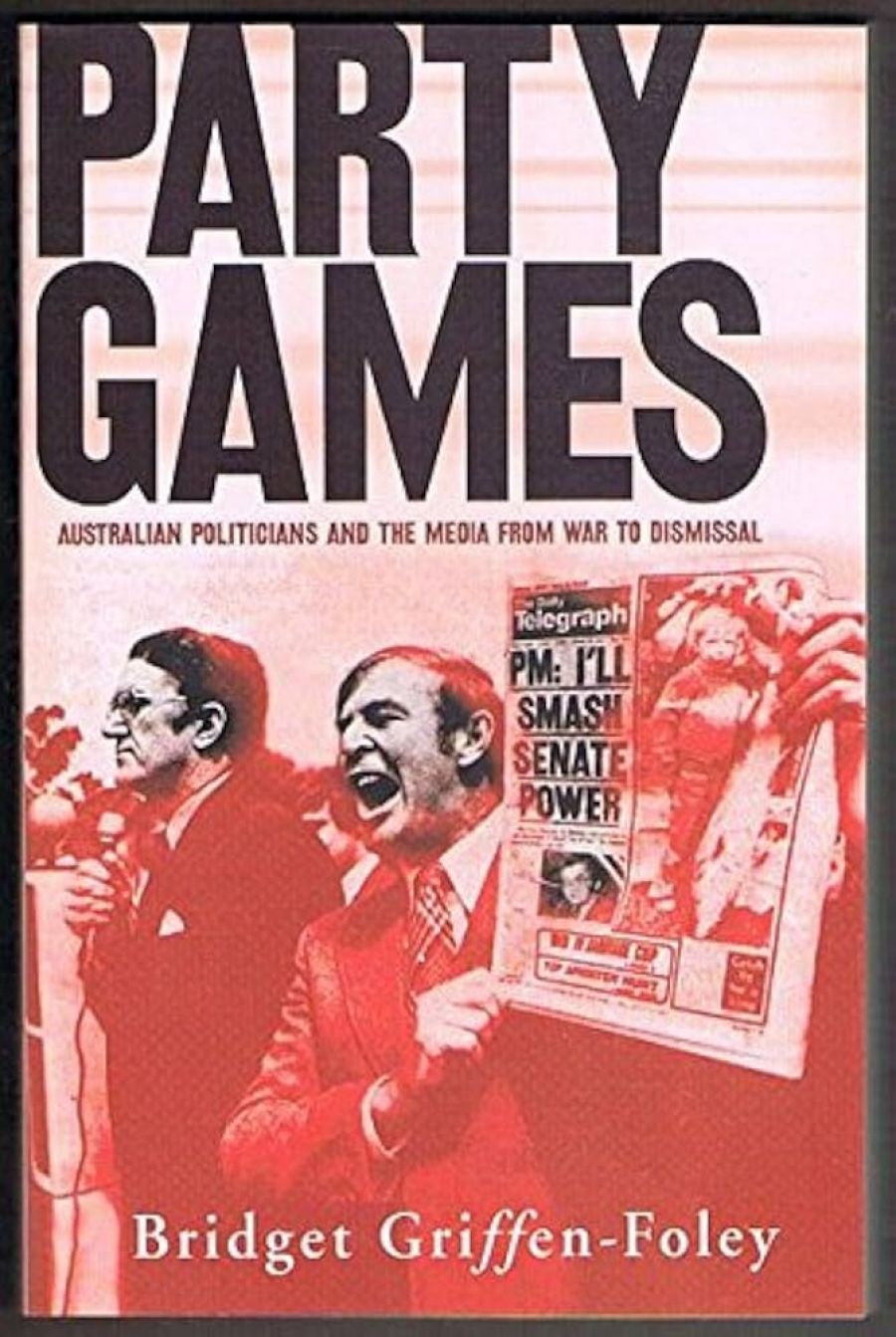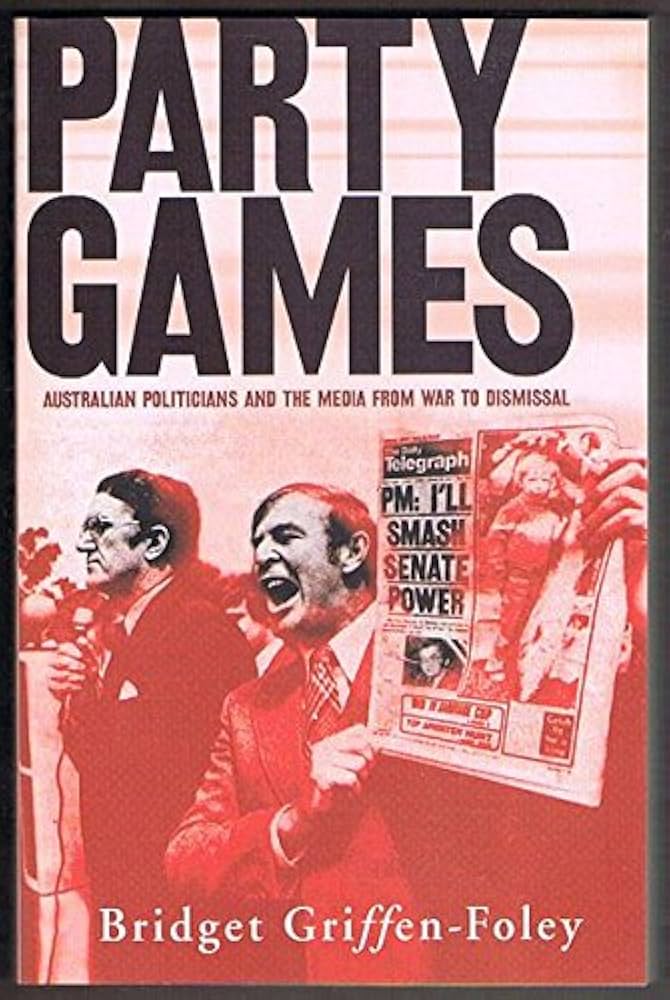
- Free Article: No
- Contents Category: Media
- Review Article: Yes
- Article Title: Threads of PR
- Online Only: No
- Custom Highlight Text:
In the aftermath of the Iraq War, any book on the history of public relations and politics seems almost quaint. That’s not a criticism, because the events and ideas Bridget Griffen-Foley analyses in Party Games: Australian politicians and the media from war to dismissal highlight just how quickly and utterly PR has insinuated itself into the life of politics. Still, it is hard to resist a cynical smile as you read of the then Liberal Party president, R.G. Casey, noting in 1947 that ‘he had learned from an American friend of a new profession called “Public Relations”’. Showing the sort of political prescience that underpinned Robert Menzies’ success, Casey became convinced of the ‘need to create a “favourable atmosphere” to advance one’s causes or interests’. Fast forward to the likes of Alastair Campbell, the head of strategic communications for the Blair government, or even our own Peter Reith, and the naïveté of the immediate post-World War II period seems positively disarming.
- Book 1 Title: Party Games
- Book 1 Subtitle: Australian politicians and the media from war to dismissal
- Book 1 Biblio: Text Publishing, $32 pb, 292 pp
- Book 1 Cover Small (400 x 600):

- Book 1 Cover (800 x 1200):

This is the real strength of Party Games. Griffen-Foley, inspired by present-day connections between media and politics, has tracked down the origins of the relationship, revealing how their intertwinement has informed and corrupted both entities. Beyond the dominant players of the time, such as Keith Murdoch, Frank Packer and the political élite, another cast of fascinating players emerge – men such as advertising executive Solomon (Sim) Rubensohn, who worked both sides of the political street, depending on personal conviction and the nature of the campaign, and Don Rodgers and Edgar Holt, who worked for John Curtin and Robert Menzies, respectively.
In following the thread of PR, Griffen-Foley does not overlook the role of political journalists, an important group of individuals in the postwar years when the parliamentary press gallery in Canberra numbered fewer than ten scribes. Rather, the author has provided a ‘measured consideration of how politicians, party officials, media proprietors, media executives, editors and journalists directly intersected’. It is the sense of these intersections, the lived experience of encounters between media barons such as Keith Murdoch and politicians such as Menzies and Evatt, that provide another dimension to Australian politics. Oh, to have been in the room in 1943 when a message from Evatt was delivered to Murdoch enquiring whether the latter might be interested in becoming a ‘minister-at-large in South America’, Evatt’s idea being to remove the thorn of Murdoch’s constant criticism from his political life.
Murdoch had too much to do at home to be tempted by such a ludicrous offer. For a start, there were political careers to make or break. The role of kingmaker sat well with Murdoch, who was never diffident about making his views apparent. Griffen-Foley builds a complex portrait of a man who had to overcome his initial doubts about Menzies (‘a little too flabby physically and mentally’) to enthusiastically endorse the Liberal leader. The PR machine swung into gear, and the cult of personality grew quickly. Favoured by comparisons with the intellectually formidable but politically erratic Evatt, Menzies underwent a political makeover. His aloof demeanour and patrician values were refashioned to suggest an ‘assured and avuncular’ leader.
The broader context of the Cold War was another crucial element in galvanising the forces of PR in pursuit of political success. As we know all too well, there is nothing like a highly politicised international conflict to enthuse PR people. The challenge in the mid-1950s was how to maximise the impact of the strategy aimed at making Menzies seem statesmanlike and above the rough and tumble of politics, while ensuring that Evatt seemed just the opposite. Evatt’s noble but sometimes ill-fated efforts to defend people caught in the anti-Communist crusade of the times often worked into the hands of Liberal Party strategists. In fact, the Liberal Party’s main spin doctor (an expression still latent within the system) was Edgar Holt, a prominent political journalist and someone who had realised even before Menzies’ 1949 victory that PR ‘is largely salesmanship, but one must know precisely what is to be sold’. Leadership, stability, integrity: these were (and remain) the most valuable political commodities. In the mid-1950s the combination of a red-scare campaign and the first visit to Australia by a reigning British monarch provided Menzies’ PR strategists with the stuff of marketing dreams.
Griffen-Foley moves the story along at a brisk pace. The drama of the 1954 elections, when a government struggling in the polls was catapulted ahead by the dramatic intervention of the Petrov Affair is covered extremely well. (The comparisons with John Howard’s Tampa election in 2001 are unnerving.) As the 1950s gave way to the turbulent 1960s, the next major influence on the relationship between politicians and the media is introduced – television.
These days, television and politics are inseparable. What would life be like without Kerry O’Brien and Laurie Oakes forensically pursuing politicians under the hot glare of the studio lights, not to mention the cast of bizarre characters and infuriating jingles that have flavoured party political advertising over the years? Understanding how this crucial innovation transformed Australia is another strength of Party Games. Griffen-Foley reveals that it was a slow process. Eighteen months after television made its début in Sydney and Melbourne, the Liberal Party federal secretariat still had not invested in a set. Edgar Holt was beside himself with frustration, and implored the federal director, Bob Willoughby, to ‘at least acquire one set’.
But once the power of the new medium became apparent, the political élite realised the significance of television with its usual alacrity. Programmes such as Meet the Press and Face the Nation were copied from US television and adapted for Australian audiences. Journalists and editors from the print world became moderators and panellists, forging a link between media. The overlapping of interests was a hallmark of television from the start.
But television imposed new demands on the politicians. As anyone who has worked in the electronic media knows, not everyone is ‘good talent’. While detailing the many political developments that marked television’s establishment in this country, Griffen-Foley also manages to capture the human (and humorous) side of the innovation. Whereas Menzies became a ‘relaxed and confident television performer’, the small screen was less kind to men such as Evatt and William McMahon. For Labor, it took the presence, gravitas and theatricality of Gough Whitlam to make television an advantageous terrain.
Perhaps the most disappointing aspect of this book is that it stops in 1975. The rise and rise of Rupert Murdoch in the following years is but one aspect of the story that remains untold. Griffen-Foley has provided readers with the information needed to make sense of relationships that now help to determine the practice of politics in Australia. The role of PR advisers, the power of the media, the capacity of politicians to provide ‘favours’ for media barons, are constant elements in public debate. Think of the fury generated by the ‘children overboard affair’ and the lingering anger occasioned by the whole ‘Weapons of Mass Destruction’ debate. We can only hope that Griffen-Foley is preparing a companion volume to bring us up to date.


Comments powered by CComment